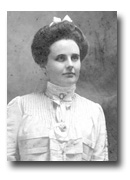



Loudoun was the home of my father's mother's family since 1772, the earliest date so far established for Jocab Kälor when he paid tithables in Loudoun. Allied families that intermarried and lived in Loudoun since the late 1700s and early 1800s were:
| Ankers | -- |
| Arundel | -- |
| Dove | -- |
| Edwards | came earlier from St Mary's County, Maryland |
| Franklin | -- |
| Havener | likely Germanic |
| Houser/Howser | likely Germanic |
| LeFevre/Lefever | originally from France |
| Lyon/Lyons | possibly from Scotland |
| Moffett/Maffett | originally from Scotland |
| Moran | came from Maryland, but originally from Ireland |
| Muse | -- |
| Oatyar/Etcher | probably Germanic |
| Primm | came from Stafford County, Virginia |
| Shryock | Germanic |
Most of these families had their Loudoun origins in the old Broad Run district, located southeast of Leesburg, between Broad Run and Goose Creek. A number of these family members have helped me over the years and my thanks go to: Charles James Christopher Maffett, Betsy Caylor Carter, Arlene Rupertis Cox, and Aaron Caylor. Their stories, photos and family histories have given more depth to the family than simply dates and names. Some of this information is included here.
Yardley's map of Loudoun, in a reproduction dated 1976,5 can be bought at the gift shop of the Loudoun Museum.
A useful older history, published in 1908, of the county is by James Head.6 The best of
current books on the history of Loudoun, especially from a social history perspective, are those of
Eugene Scheel, historian and map-maker, of Waterford.7 His newspaper columns on Loudoun, it's
history and people, in The Washington Post are excellent and worth a read - to access them, use
the ProQuest web site (for a fee).
The
best of the web sites that focus on Loudoun history are at
www.loudounhistory.org where there is a comprehensive history of Loudoun
(www.loudounhistory.org/site-index.htm) and a
special history of Waterford (www.waterfordhistory.org).
The many photographs on both sites are worth examining.
John Lefevre's "Hillside" farm was built by John Alexander Caylor in 1874 and has been preserved - see the plaque across the road from the farm that explains its history. John Caylor worked for the railroad over many years in the late 1800s and the photograph shows him with other workers at the Washington & Old Dominion Railroad.
Charles James Craven Maffett had both a farm and a mercantile store in Arcola and the store was used as a post office from 1909-1915. Arcola had a three-quarter mile oval track (Arcola Racefield) for horse racing, which continued from the 1800s until about 1910.
1. Joshua Fry and Peter Jefferson, Map of the Most Inhabited Part of Virginia Containing the Whole
Province of Maryland with Part of Pensilvania, New Jersey and North Carolina (London: Thos. Jefferys, 1755).
Map was drawn in 1751 and can be viewed on-line at
http://lcweb2.loc.gov/ammem/gmdhtml/gmdhome.html.
2. John T Phillips II, The Historian’s Guide to Loudoun County, Virginia, Volume I: Colonial Laws
of Virginia and County Court Orders, 1757-1766 (Leesburg & Middleburg, Virginia: Goose Creek
Productions, 1996), insert before page 1.
3. David H Burr, Map of Virginia, Maryland and Delaware (London: John Arrowsmith, 1839), accessed at
the David Rumsey Collection, www.davidrumsey.com.
4. U.S. War Department, Topographical Engineers, Map of N. Eastern Virginia and Vicinity of Washington
compiled in Topographical Engineers Office at Division Head Quarters of General Irvin McDowell Arlington,
January 1th 1862 corrected from recent Surveys and Reconnaissances under the direction of the Bureau of
Topographical Engineers August 1st 1862 (New York: J Schedler, 1862), accessed at the David
Rumsey Collection, www.davidrumsey.com. Most of the information in
the map was taken from Yardley Taylor’s 1853 map of Loudoun.
5. Yardley Taylor, Map of Loudoun County, Virginia from Actual Surveys (Philadelphia: Thomas Reynolds
and Robert Pearsall Smith, 1853). New edition published 1976 by A.M. and W.L. Janney, Lincoln, Virginia.
6. James W Head, History and Comprehensive Description of Loudoun County Virginia (1908; reprint,
Baltimore: Clearfield Company, 1989).
7. Eugene M Scheel, Loudoun Discovered: Communities, Corners & Crossroads, Vols 1-5 (Leesburg,
Virginia: The Friends of the Thomas Balch Library, 2002). His excellent map of the county can be purchased
for $10 through the Balch Library.